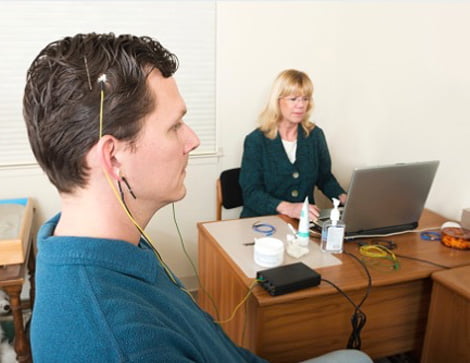Biofeedback – The Ultimate Self-Help Discipline by Othmer S Ph.D. and Grierson C RN BCIACBiofeedback opens a new channel of communication between you and your own body. Becoming aware of your own body can help it to become more functional. There are two basic ways of achieving this. One is to quiet and calm the mind, so that it can become more aware of body states. An example of this is paying attention to your own breathing. The other way is to bring up the “signal level” to where it is recognizable and obvious. READ FULL TEXT
Related Research
Preliminary Results of an Open Label Study of Heart Rate Variability Biofeedback for the Treatment of Major Depression by Karavidas MK, Lehrer PM, Vaschillo E, Vaschillo B, Marin H, Buyske S, Malinovsky I, Radvanski D, Hassett AMajor depressive disorder (MDD) is a common mood disorder that can result in significant discomfort as well as interpersonal and functional disability. A growing body of research indicates that autonomic function is altered in depression, as evidenced by impaired baroreflex sensitivity, changes in heart rate, and reduced heart rate variability (HRV). READ FULL TEXT
Biofeedback Treatment for Asthma by Lehrer PM Ph.D., Vaschillo E Ph.D., Vaschillo B M.D., Lu S-E Ph.D., Scardella A M.D. FCCP, Siddique M D.O. FCCP, Habib RH Ph.D.An effective nonpharmacologic alternative or adjunctive treatment of asthma could provide a potentially useful contribution to asthma care. Adherence to asthma regimens tends to be low, and the resort to complementary treatments is common despite the lack of evidence for effectiveness. The long-term use of oral steroids is expensive and can have undesirable side effects. READ FULL TEXT (PDF FORMAT)
Combined Heart Rate Variability and Pulse Oximetry Biofeedback for Chronic Obstructive Pulmonary Disease: Preliminary Findings by Giardino ND, Chan L, Borson SThe purpose of this study was to examine the feasibility of an intervention that included heart rate variability (HRV) biofeedback and walking with pulse oximetry feedback to improve functioning and quality of life for patients with chronic obstructive pulmonary disease (COPD). READ FULL TEXT
Learned Regulation of Spatially Localized Brain Activation Using Real-Time fMRI by deCharms CR, Christoff K, Glover GH, Pauly JM, Whitfield S, Gabrielia JDEIt is not currently known whether subjects can learn to voluntarily control activation in localized regions of their own brain using neuroimaging. Here, we show that subjects were able to learn enhanced voluntary control over task-specific activation in a chosen target region, the somatomotor cortex. READ FULL TEXT (PDF FORMAT)
Ascorbic Acid and Some Other Modern Analogs of the Germ Theory by Ely JTA Ph.D. – University of WashingtonThere is an almost universally held view that medicine is and should be a prestigious profession. Sadly, in recent decades, significant erosion of this view has occurred. The general nature of the erosion and other published laments are cited here. There is preponderant agreement among scientists and the lay public that medicine has an obligation to know what “is known” (ie, that given modalities have been reported in the literature by competent authors to be far superior to corresponding treatments of choice, but their adoption has been opposed without reason). READ FULL TEXT
VITAMIN C (ASCORBIC ACID) by Various AuthorsOver 150 abstracts on the use of Vitamin C with Cardio-Vascular Disease, Cancer and infectious diseases. (Life Extension Foundation) READ FULL TEXT
Journal of Orthomolecular Medicine ArchivesThe database below represents the sum total of the published papers of the Journal of Orthomolecular Medicine. This publication began as the Journal of Schizophrenia in 1967. After 1968, the name was changed to Schizophrenia, and from 1971 the name was again changed to Orthomolecular Psychiatry to reflect the increased scope of this type of therapy to other mental illnesses. In 1986, as it became clear that nutritional therapy was widely applicable to both physical as well as mental disease, the publication underwent a final change to the more inclusive Journal of Orthomolecular Medicine and is presently published as such today. READ FULL TEXT
Epidemiology Shows That Vitamin C Helps Us Live Longer © Interview with Dr. James E. Enstrom Interviewed by Richard A. Passwater Ph.D.In May, very exciting nutrition headlines captured the interest of nearly everyone. [1,2] A long-time colleague and friend of mine, Dr. James E. Enstrom of the UCLA School of Public Health, published his latest research on how men taking vitamin C, about 300 milligrams or more per day, on average live six years longer than those who receive less than 50 milligrams of vitamin C daily. READ FULL TEXT
Publications on Vitamin C (ascorbic acid) by Cathcart RF M.D.A remarkable increase in the tolerance to Vitamin C in ill patients has been observed. Roughly 80% of well patients will tolerate about 12 to 16 grams a day in divided doses before diarrhea is produced. These same patients will easily tolerate 30 to 60 grams a day divided in 4 to 6 gram and sometimes 8 to 12 gram doses when acutely ill. Only then does the Vitamin C always produce diarrhea. This dramatic difference in the same patient required to produce diarrhea strongly suggests an increased absorption with viral diseases for some reason. read full textREAD FULL TEXT

Comments are closed